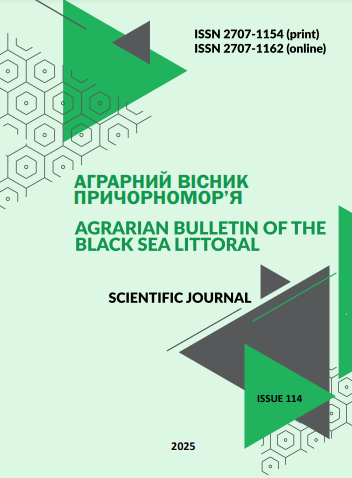THE IMPACT OF CLIMATE CHANGE IN SOUTHERN UKRAINE ON THE FEEDING STANDARDS FOR DOGS KEPT OUTDOORS IN WINTER
DOI:
https://doi.org/10.37000/abbsl.2025.114.17Keywords:
climate, feeding standards, feed, temperature, dogs, housing.Abstract
The rational feeding of dogs kept outdoors during the winter period has not been sufficiently studied, given that there are many different climatic regions in the world with their own specific environmental conditions and climate variations, which have been increasingly subject to change in the recent years. This fact alone accounts for the relevance of research in this area, which requires additional attention. According to the latest recommendations on the feeding standards for dogs kept outdoors during the winter period, it is suggested that their diet should be increased by 15% in terms of its energy content.
The carried out investigation has disclosed the outcomes of various dog feeding practices, taking into account the climate of southern Ukraine and its recent changes. The data obtained provide grounds for revising the recommendations given in the scientific literature, since those do not specify the region of our country and its climatic features.
The findings of the study indicate that dogs of the first control group and the second experimental group had significant changes in their live weight and were 4.1 % higher when their daily diet was increased by 15 % and 20 %, respectively in its energy content. The height of the third experimental group grew by 6.9 %, which is not a desirable factor for the animals after finishing their physiological development. In contrast, the first experimental group, which consumed a diet with a 10% rise in its energy content in winter, had no changes in their live weight.
These results indicate that irrational feeding of dogs without taking into account the climatic conditions of the environment causes a possible increase in their live weight and can provoke animals' obesity, later on deteriorating their general health.
References
Mogilev, M. P. (2004). Dog breeding. Kyiv: OJSC Satelit. Р.389. [in Ukrainian].
Shevchuk, I. S. (2000). Cynology. Kyiv: OJSC Garrison. P.400. [in Ukrainian].
Yusipov, V. V. (2003). Dog feedin. Kyiv: OJSC Satelit. P.350. [in Ukrainian].
Burlaka, V. A., Pavlyuk, V. A., & Stepanenkota, V. M. (2004). Cynology: keeping and feeding dogs. Zhytomyr: Volyn. P. 412. [in Ukrainian].
Dekhtyarov, P. A., Samoilyuk, V. V., Ushkalov, V. O., & Stegniy, B. T. (2004). Anatomy and physiology of a dog. Kharkiv: IEKVM. P.164. [in Ukrainian].
Zulyanych, I. F., Kostetska, K. V., & Golubev, M. I. (2017). Assessment of the microbiological state of feed mixtures during their storage. Bulletin of the Uman National University of Horticulture, 2017, 1, (pp. 29-32). [in Ukrainian].
Law of Ukraine №131 (2012, March 19), amended (2017, October 11) № 550. On Approval of the List of Maximum Permissible Levels of Undesirable Substances in Feed and Feed Raw Materials for Animals. Official Gazette of Ukraine, P. 20. [in Ukrainian].
Resolution of the Cabinet of Ministers of Ukraine №336 (1992, 16 June). Daily feeding standards for service dogs [in Ukrainian].
Polishchuk, F. I., & Trofymenko, O. L. (2007). Cynology. Kyiv: Perun. P. 1000. [in Ukrainian].
Sobol, O. M. (2020). The use of different types of dog feeding in connection with their size and breed. Modern challenges and current problems of science, education and production (pp. 301–306). Kyiv [in Ukrainian].
Khimich, M. S., & Biloshitska, I. I. (2015). Analysis of the domestic market of feed for non-productive animals. Scientific Bulletin of the LNUVMBT named after S.Z. Gzhytsky, 17, 1(61), 2, (pp. 302–307) [in Ukrainian].
Nikolenko, I. V., Kyshlaly, O. K., & Mazhylovska, K. R. (2022). Methodological instructions for conducting laboratory and practical classes on the discipline “Feeding and maintenance of dogs”. Odesa: ODAU. P. 33. [in Ukrainian].
Bilan, M. V., Gavrylina, O. G., & Konovyi, E. R. (2019). Qualitative analysis of dry dog food. Theoretical and Applied Veterinary Medicine, 7(4), (pp. 215–222). doi: 10.32819/2019.74038 [in Ukrainian].
Day, C. (2020). Feeding dogs. Alternative Veterinary Medicine Centre. http://www.users.globalnet.co.uk/~avmc/Feeding%20Dogs%20WS13807.pdf.svobodnyi
Hofve, J. (2013). 10 Reasons why dry food is bad for cats & dogs. Little Big Cat. https:// littlebigcat.com/nutrition/why-dry-food-is-bad-for-cats-and-dogs
Downloads
Published
How to Cite
Issue
Section
License

This work is licensed under a Creative Commons Attribution-NonCommercial 4.0 International License.


